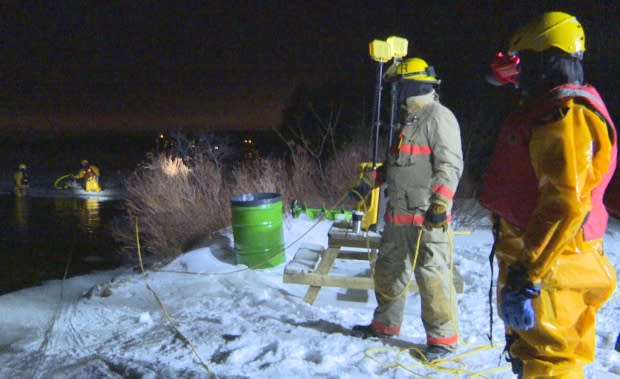Firefighters plunge into icy waters, so they know how to save people that fall in
In the black of night, in -5 C weather, volunteer firefighters with the Portugal Cove-St. Philip's fire department plunge into the freezing water of Healey's Pond in St. John's.
Firefighters spent a few hours Monday night simulating a real-life rescue situation to make sure they're prepared in case of an emergency.
"We have about 30 ponds within our town so there are a lot of opportunities, a lot of people on the ponds," said deputy fire chief Ed Sharpe shortly after taking he got out of the water.
Members took turns bobbing in a hole carved into the 18-inch-thick ice. Using ropes, life buoys and other specialized equipment, they practiced saving one another several times.
That practice is important, because they need to be able to do it quickly.

"From the time the call goes into 911 and we get dispatched or respond to a scene, a person has been in the water for quite a long time," said Sharpe.
"It could be five to 10 minutes, if they are in a pond that is not accessible by the road, it could be even longer."
Watch for thin ice
The waterproof suits firefighters wear while training are a stark reminder that people who fall through the ice do not, Sharpe said.
"You can only imagine how it would be like to be in that water with snowsuits on, or running pants."

That's why he's asking people to be cautious while exploring near ponds, rivers and streams. His recommendation is to check the thickness of the ice before getting on it.
"Take an auger, check the holes, check in multiple places … You don't know, there could be underflows and things that make the ice thinner," he said.
Watch a controlled, icy plunge in the video below.
Paul French, a volunteer with Rover's ice water rescue team, said the number-one thing people should remember if they happen to fall through the ice is the 1-10-1 principle: one minute to control your breathing and get your head above the water, 10 minutes of meaningful movement, and one hour before becoming unconscious due to hypothermia.
"There's a big myth out there that hypothermia is going to kill you in a matter of minutes and that is not true," said French. "Once you get your breathing under control … you want to work on getting yourself out of the water and up onto the ice."

French said it's important to turn around in the water and get out where you got in because the ice was strong enough to hold you before you fell in.
"You got to act like a seal. Put your arms up on the ice and you want to kind of lift your body and kick, kick, kick your feet as fast as you can and slide up onto the ice."

According to the Canadian Red Cross, there were no unintended water-related deaths in the winter months for 2018.
In total, there were 13 water-related deaths in Newfoundland and Labrador last year. However, some of those incidents did not involve drowning.
Read more articles from CBC Newfoundland and Labrador

